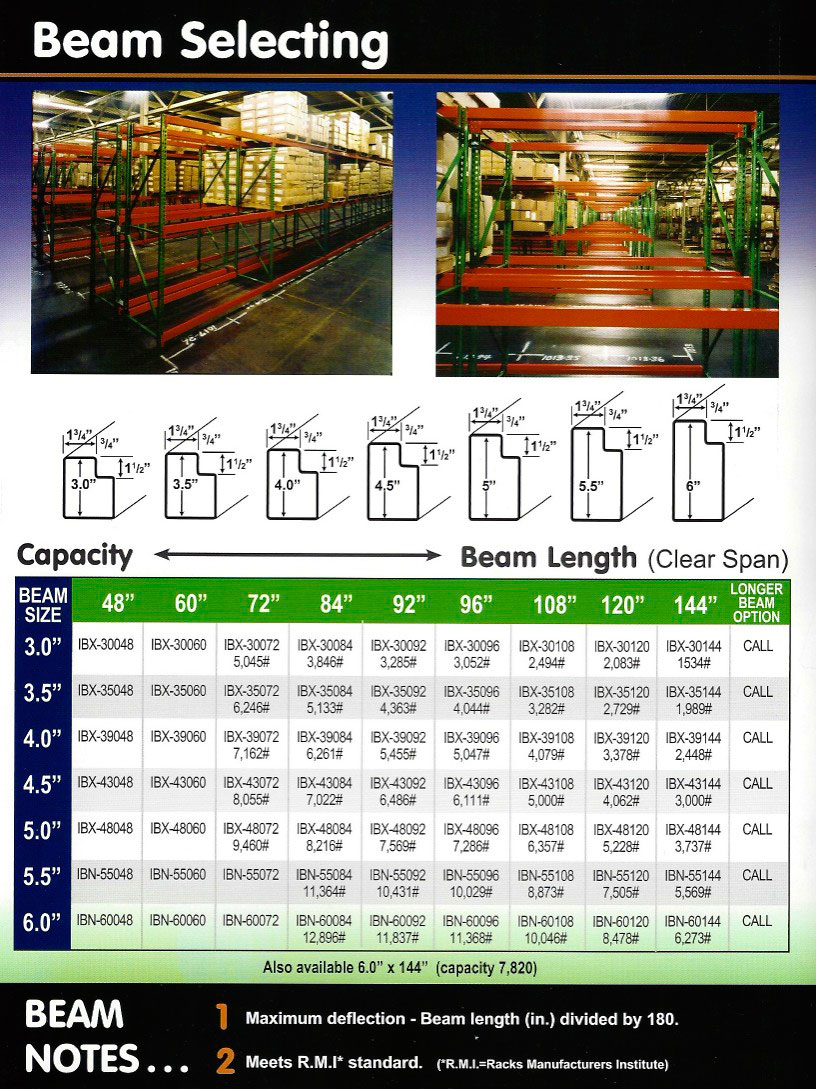Rack Men stocks Husky pallet rack uprights and beams in our Cartersville, Georgia warehouse. This page features Husky Rack and Wire upright and beam capacity chart. This capacity chart is engineered for static, non-seismic loads. Consult with our engineers when designing pallet racking systems
in seismic areas and dynamic/live loads such as pallet flow rack. Note that all manufacturers capacity charts are based on zero seismic areas, which is a perfect world. We do not live in a perfect world.
UPRIGHT CAPACITY
Pallet rack upright capacities are determined by the dimension of the upright column, the gauge of the column steel, and the spacing of the beams. “Spacing” is the distance from the floor to the top of the first beam level. If the maximum opening is not the floor level, spacing is the distance from the top of the beam to the top of the beam above plus 1”. The closer the beams are spaced, the higher the capacity. When beams are spaced further apart, capacity is reduced. The upright capacity chart below depicts the uprights capacity when the beams are spaced from 36” to 96” apart. For upright capacities with beam spacing greater than 96” please call Rack Men. According to the chart, when beams are spaced at 36” on an IU18 upright (3” x 1 5/8” column made of 14 gauge steel) the capacity is19,380 pound capacity, but at 96” beam spacing, the capacity of the same upright is reduced to 6,500 pound capacity. As you can see, altering your beam spacing can cause a dramatic change in your uprights capacity. Upright column posts can be double reinforced to increase the capacity of the uprights for special applications. When the bottom portion of upright frames is exposed to potential impacts by forklifts or equipment, consider purchasing optional impact protection devices. When installing uprights make sure they are level, plumb, and square. Shim plates are used to level the uprights before anchoring.
Beam Capacity
Rack Men stocks Husky Rack and Wire load beams. New Husky beams have the load capacity rating clearly marked on every beam. Husky Rack & Wire is one of the few manufacturers that clearly state the capacity of their beams. Make sure that your uprights can handle the weight of multiple levels of load beams. See the above paragraph and upright capacity chart to determine your upright capacity. Please note the load beam capacities are rated per pair of beams with uniform load distribution that is the load is evenly spread out over the entire pair of beams. That is each beam is carries 50% of the load. Point loading beams can lead to failure. If a pallet load has the majority of the weight concentrated on a portion of the pallet, then this is not a uniform load and could put undo stress on one of the load beams. Call Rack Men when you have non-uniform loads. When beams are loaded to their stated capacity, they will deflect or bow. The maximum allowable beam deflection is the length of the beam divided by 180. Therefore a 96” beam / 180 = 0.53”, so a 96” beam is allowed to deflect ½”. A 144” beam / 180 = 0.8”, a 144” beam is allowed to deflect ¾”. To measure your beam deflection, measure the distance from the floor to the bottom of the beam closest to the upright, and then measure the distance to the center and subtract. If your beams deflect more that the length/180 your beams are overloaded. If the beams have a permanent bow, then they are stressed out and need to be replaced. Beams over 116” long should be tied across the middle to prevent beam spread. Beams over 90” long that support loose deck (inlay decking) should be tied across the middle to prevent beam spread.
RACK MEN’S THOUGHTS
At Rack Men, we build storage systems to stand the test of time. One question I usually ask a customer is, “What is the heaviest pallet weight you have?” Then I design a system around that pallet weight. That way the customer can be sure that their forklift drivers will not overload their racking system. If a customer is going to put 5,000 pounds per beam level, I suggest we take the capacity up to the next level, as an example to 6,000 pounds. That way you will not see as much beam deflection. Same rule applies for choosing your uprights, if a 3” x 15/8” (IU18) meets your load requirements taking a step up to the stronger 3” x 3” column (IU24) will make your system more resistant to damage. Damaged uprights and beams need to be unloaded and replaced immediately as they can pose a serious safety hazard. Whenever you have questions about your storage system, call Rack Men. While I was writing this, a customer called and said they had a rack collapse, and asked me to come out to determine the cause. The beams had a capacity of 8,873 pounds per beam pair uniform load distribution; the load on the beams was 8,400 pounds per pair of beams. The upright column spacing was 60”. The brand of the upright was unknown, but if we use Husky’s upright capacity chart, a similar upright should have a capacity of 21,100 pounds. We added the weight of 1 bay 22,850 pounds. The floor had a slight pitch and the uprights were not shimmed and level. This was not a Rack Men installation. The cause of the rack failure was due to 3 things. The uprights were overloaded. The floor was not level and the uprights were not shimmed to make them plumb and level. The pallet on the floor only had 2” of lift off spacing, and I believe it caught the bottom of the first beam level and started the upright collapse in motion. We rarely see a rack collapse, but it is a dangerous situation. It is important to design your pallet rack system to be stronger than your maximum load and to meet the codes in your area so that it will hold your product for many years to come.
Wire Deck Capacity
At Rack Men, we stock Nashville Wire Products wire decking for pallet racks. When Rack Men quotes a new wire deck, the items description will have a rated capacity of that deck. The rated capacity of a wire deck is for static (stable or unchanging) loads that are uniformly distributed over the entire rack deck and within the allowable load capacity. Placing a load in the middle of a wire deck without the support of load beams or point loading a wire deck can cause the deck to fail. Loads should be placed onto the decking rather than being dropped. Loads should not be pushed or pulled across the surface of the deck. Wire decking should not be used for a walkway or platform for personnel. Failure to adhere to these guidelines could result in serious injury. Nashville Wire Products welded-wire decking for rack storage is designed and manufactured in conformance with ANSI standard MH26.2.





